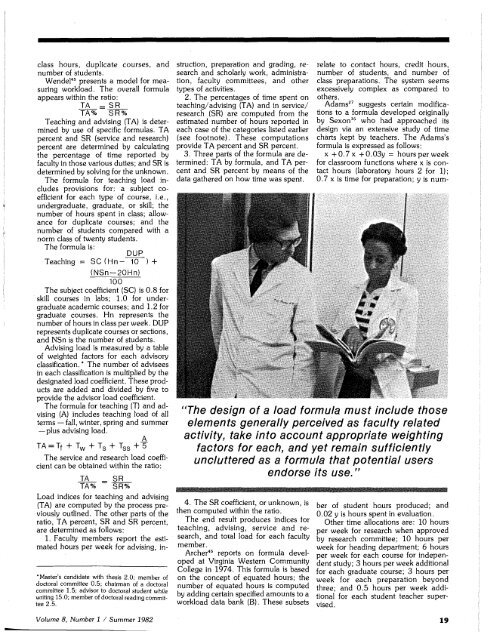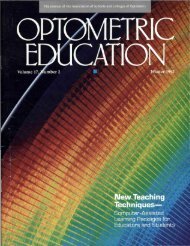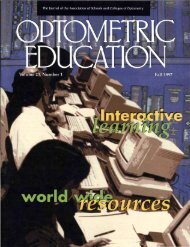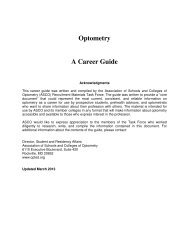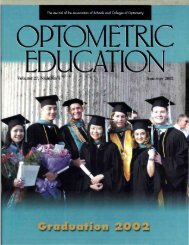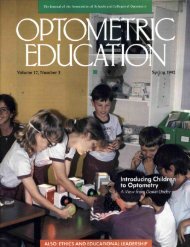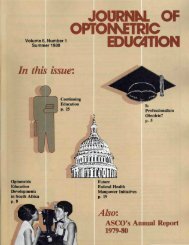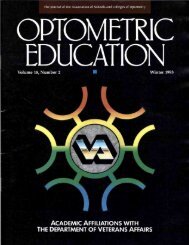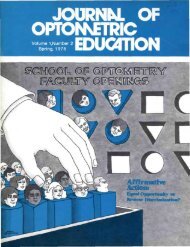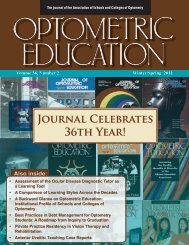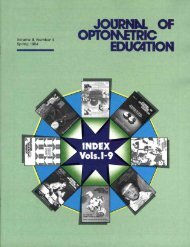JOURNN. OF - Association of Schools and Colleges of Optometry
JOURNN. OF - Association of Schools and Colleges of Optometry
JOURNN. OF - Association of Schools and Colleges of Optometry
Create successful ePaper yourself
Turn your PDF publications into a flip-book with our unique Google optimized e-Paper software.
class hours, duplicate courses, <strong>and</strong><br />
number <strong>of</strong> students.<br />
Wendel 45 presents a model for measuring<br />
workload. The overall formula<br />
appears within the ratio:<br />
TA = SR<br />
TA% SR%<br />
Teaching <strong>and</strong> advising (TA) is determined<br />
by use <strong>of</strong> specific formulas. TA<br />
percent <strong>and</strong> SR (service <strong>and</strong> research)<br />
percent are determined by calculating<br />
the percentage <strong>of</strong> time reported by<br />
faculty in those various duties; <strong>and</strong> SR is<br />
determined by solving for the unknown.<br />
The formula for teaching load includes<br />
provisions for: a subject coefficient<br />
for each type <strong>of</strong> course, i.e.,<br />
undergraduate, graduate, or skill; the<br />
number <strong>of</strong> hours spent in class; allowance<br />
for duplicate courses; <strong>and</strong> the<br />
number <strong>of</strong> students compared with a<br />
norm class <strong>of</strong> twenty students.<br />
The formula is:<br />
PUP<br />
Teaching = SC (Hn- 10 ) +<br />
(NSn-20Hn)<br />
100<br />
The subject coefficient (SC) is 0.8 for<br />
skill courses in labs; 1.0 for undergraduate<br />
academic courses; <strong>and</strong> 1.2 for<br />
graduate courses. Hn represents the<br />
number <strong>of</strong> hours in class per week. DUP<br />
represents duplicate courses or sections,<br />
<strong>and</strong> NSn is the number <strong>of</strong> students.<br />
Advising load is measured by a table<br />
<strong>of</strong> weighted factors for each advisory<br />
classification.* The number <strong>of</strong> advisees<br />
in each classification is multiplied by the<br />
designated load coefficient. These products<br />
are added <strong>and</strong> divided by five to<br />
provide the advisor load coefficient.<br />
The formula for teaching (T) <strong>and</strong> advising<br />
(A) includes teaching load <strong>of</strong> all<br />
terms —fall, winter,spring <strong>and</strong> summer<br />
—plus advising load.<br />
TA = T f + T W +T S + T SS +T<br />
The service <strong>and</strong> research load coefficient<br />
can be obtained within the ratio:<br />
TA = SR<br />
TA% SR%<br />
Load indices for teaching <strong>and</strong> advising<br />
(TA) are computed by the process previously<br />
outlined. The other parts <strong>of</strong> the<br />
ratio, TA percent, SR <strong>and</strong> SR percent,<br />
are determined as follows:<br />
1. Faculty members report the estimated<br />
hours per week for advising, in-<br />
"Master's c<strong>and</strong>idate with thesis 2.0; member <strong>of</strong><br />
doctoral committee 0.5; chairman <strong>of</strong> a doctoral<br />
committee 1.5; advisor to doctoral student while<br />
writing 15.0; member <strong>of</strong> doctoral reading committee<br />
2.5.<br />
struction, preparation <strong>and</strong> grading, research<br />
<strong>and</strong> scholarly work, administration,<br />
faculty committees, <strong>and</strong> other<br />
types <strong>of</strong> activities.<br />
2. The percentages <strong>of</strong> time spent on<br />
teaching/advising (TA) <strong>and</strong> in service/<br />
research (SR) are computed from the<br />
estimated number <strong>of</strong> hours reported in<br />
each case <strong>of</strong> the categories listed earlier<br />
(see footnote). These computations<br />
provide TA percent <strong>and</strong> SR percent.<br />
3. Three parts <strong>of</strong> the formula are determined:<br />
TA by formula, <strong>and</strong> TA percent<br />
<strong>and</strong> SR percent by means <strong>of</strong> the<br />
data gathered on how time was spent.<br />
.».<br />
relate to contact hours, credit hours,<br />
number <strong>of</strong> students, <strong>and</strong> number <strong>of</strong><br />
class preparations. The system seems<br />
excessively complex as compared to<br />
others.<br />
Adams 27 suggests certain modifications<br />
to a formula developed originally<br />
by Sexon 35 who had approached its<br />
design via an extensive study <strong>of</strong> time<br />
charts kept by teachers. The Adams's<br />
formula is expressed as follows:<br />
x +0.7x +0.03y = hours per week<br />
for classroom functions where x is contact<br />
hours (laboratory hours 2 for 1);<br />
0.7 x is time for preparation; y is num-<br />
"The design <strong>of</strong> a load formula must include those<br />
elements generally perceived as faculty related<br />
activity, take into account appropriate weighting<br />
factors for each, <strong>and</strong> yet remain sufficiently<br />
uncluttered as a formula that potential users<br />
endorse its use."<br />
4. The SR coefficient, or unknown, is<br />
then computed within the ratio.<br />
The end result produces indices tor<br />
teaching, advising, service <strong>and</strong> research,<br />
<strong>and</strong> total load for each faculty<br />
member.<br />
Archer 46 reports on formula developed<br />
at Virginia Western Community<br />
College in 1974. This formula is based<br />
on the concept <strong>of</strong> equated hours; the<br />
number <strong>of</strong> equated hours is computed<br />
by adding certain specified amounts to a<br />
workload data bank (B). These subsets<br />
ber <strong>of</strong> student hours produced; <strong>and</strong><br />
0.02 y is hours spent in evaluation.<br />
Other time allocations are: 10 hours<br />
per week for research when approved<br />
by research committee; 10 hours per<br />
week for heading department; 6 hours<br />
per week for each course for independent<br />
study; 3 hours per week additional<br />
for each graduate course; 3 hours per<br />
week for each preparation beyond<br />
three; <strong>and</strong> 0.5 hours per week additional<br />
for each student teacher supervised.<br />
Volume 8, Number 1 / Summer 1982 19


